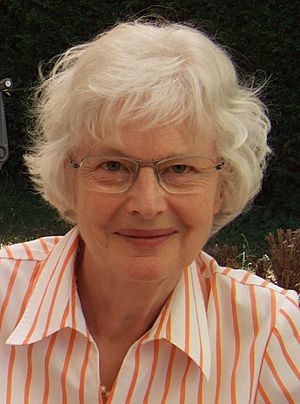Édith Lejet facts for kids
Quick facts for kids
Edith Lejet
|
|
|---|---|
 |
|
| Background information | |
| Born | 19 July 1941 Paris, German-occupied France |
| Died | 15 July 2024 (aged 82) |
| Genres | contemporary music |
| Occupation(s) | Composer, music educator |
Édith Lejet (born July 19, 1941 – died July 15, 2024) was a talented French composer and a dedicated music teacher. She created many beautiful pieces of music and helped train new musicians.
Contents
About Édith Lejet
Édith Lejet was born in Paris, France. She loved music from a young age. She studied at the famous Paris Conservatory, a top music school. There, she learned about different parts of music, like harmony and composition. Her teachers included well-known composers such as Jean Rivier and Andre Jolivet.
After her studies, Lejet lived in Madrid, Spain, for a few years. She then returned to Paris to share her knowledge. She started teaching music at the Sorbonne, a very old and respected university. Later, she became a professor at the National Conservatory of Music and Dance in Paris. This is one of the most important music schools in the world.
In 2004, she also became a professor of composition at the École Normale de Musique de Paris Alfred Cortot. This meant she taught students how to create their own music. Édith Lejet passed away in 2024, at the age of 82. She left behind a legacy of wonderful music and many students she inspired.
Awards and Recognition
Édith Lejet received many important awards for her musical talent. These awards showed how much her work was appreciated.
- In 1967, she won the Prize Bleustein-Blanchet.
- She also received the Florence Gould Prize from the Academy of Fine Arts in Paris.
- The William and Nomma Copley Foundation Award from Chicago was another honor.
- She won the Prize Herve Dugardin from SACEM in Paris.
- In 1968, she earned the Second Grand Prix de Rome. This is a very prestigious award for artists.
- The Music Awards Board of SACEM recognized her in 1979.
- She was named an Honorary Professor at the National Conservatory of Music and Dance in Paris.
- In 2003, she received the Nadia and Lili Boulanger Prize from the Academy of Fine Arts.
Her Musical Works
Édith Lejet composed a wide variety of music. She wrote pieces for single instruments, small groups, and even full orchestras. Her music often explored different sounds and emotions.
Music for Solo Instruments
Lejet wrote many pieces for just one instrument. She composed for the piano, creating works like Trois eaux-fortes and Fleurs d’opale. She also wrote for the organ, including Triptyque and Ave Maria. Other solo pieces were for the harp (Métamorphoses), horn (Deux soliloques), and cello (Volubilis). She even wrote several pieces for the guitar, such as Gémeaux and America.
Music for Two Instruments
She also enjoyed writing music for two instruments playing together. Some examples include Musique pour trombone et piano and Quatre pièces en duo for double bass and piano. She explored different combinations, like saxophone and piano in Saphir, or two flutes in Emeraude et Rubis.
Chamber Music
Édith Lejet composed music for small groups of instruments, known as chamber music. Her pieces include Musique pour trompette et quintette de cuivres (for trumpet and five brass instruments). She also wrote for saxophone quartets, like Quatuor de saxophones and Aube marine.
Music for Orchestras and Ensembles
Lejet's larger works included music for full orchestras or bigger groups of instruments. Monodrame was a piece for violin and orchestra. She also wrote Harmonie du soir for 12 string instruments and Ressac for a full orchestra. These pieces showed her skill in arranging music for many different sounds.
Music for Voices and Choirs
Édith Lejet also composed beautiful music for singers and choirs. She wrote Le journal d'Anne Frank for a female choir. Other vocal works included L'Homme qui avait perdu sa voix for singers and instruments, and Les Rois-mages for singers and choir. She also composed sacred music, like Sept Chants sacrés, and a Missa brevis for choir and organ.

